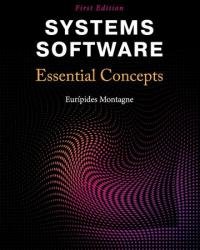Systems Software: Essential Concepts
- Добавил: literator
- Дата: 12-06-2023, 14:09
- Комментариев: 0
 Название: Systems Software: Essential Concepts
Название: Systems Software: Essential ConceptsАвтор: Euripides Montagne
Издательство: Cognella Academic Publishing
Год: 2022
Страниц: 228
Язык: английский
Формат: pdf
Размер: 51.7 MB
Systems Software: Essential Concepts provides students with an accessible introduction to the knowledge and fundamentals that are necessary to understand software and hardware. The text also reviews implementation techniques to familiarize students with more complex software, such as operating systems and compilers, and prepare them to take more advance courses within the discipline.
The book is divided into two key topical areas: compiler fundamentals and the basic mechanisms and data structures required to support operating systems. In the compiler section, students learn about the runtime environment, how to implement a scanner and a symbol table, and how to implement parsing and code generation for a virtual machine. To emphasize practical application, students are challenged to implement a small compiler. In the operating system domain, students gain an understanding of the interrupt mechanism, process and thread implementation, and process synchronization.
Featuring a modern and practical approach, Systems Software is an ideal resource for courses in system programming, systems software, software development, and assembly language. It can also serve as a supplementary material for introductory operating system and compiler courses.
Programming languages provide programmers with a vocabulary and syntax rules to allow them to write programs. A peculiarity of programming languages is that they leave a window open to programmers to permit them to insert external names into programs. Those external names, also known as identifiers, are used to identify constants, variables, and subroutines. By subroutines we mean functions, procedures, and methods. A symbol table is a data structure used to gather external names and their attributes.
Contents:
Скачать Systems Software: Essential Concepts
Внимание
Уважаемый посетитель, Вы зашли на сайт как незарегистрированный пользователь.
Мы рекомендуем Вам зарегистрироваться либо войти на сайт под своим именем.
Уважаемый посетитель, Вы зашли на сайт как незарегистрированный пользователь.
Мы рекомендуем Вам зарегистрироваться либо войти на сайт под своим именем.
Информация
Посетители, находящиеся в группе Гости, не могут оставлять комментарии к данной публикации.
Посетители, находящиеся в группе Гости, не могут оставлять комментарии к данной публикации.

